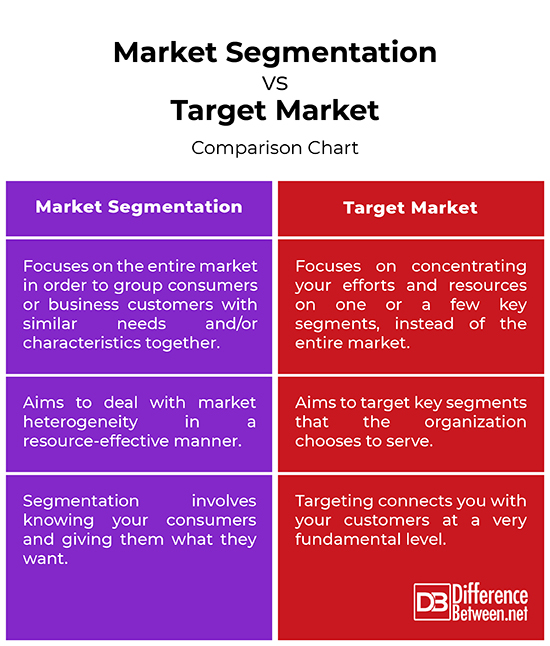Difference Between Market Segmentation and Target Market
When creating a brand, the key element is determining your target customers. Knowing and understanding your customers will help you make informed business decisions. In today’s fast-changing and highly competitive markets, having superior quality goods or services is not enough. You must satisfy discriminating customers who can choose from a multitude of offerings in a global marketplace. While segmentation-based marketing is the essence of the modern business strategy, it is sometimes confused with yet another marketing strategy, target marketing. As similar they may sound, they are not the same.

Market Segmentation
Market segmentation is an important element of the modern business marketing strategy. Academics see this concept as central to effective marketing strategy. Market segmentation is a customer driven marketing strategy that focuses on common characteristics consumers share. It is the process of grouping consumers or business customers with similar needs and/or characteristics together in a market segment. The idea is to divide a market segment into groups who are likely to exhibit similar requirements and buying habits.
For example, a smartphone manufacturer can divide its customers into three groups: budget-friendly, mid-segment, and high-tier. Segmentation, if done properly, can help deal with market heterogeneity in a resource-effective manner. The key to business success lies in its ability to meet the needs of customers. Market segmentation helps achieve this objective. But how do businesses segment customers? Businesses do that by looking at demographics, psychographics, geography, and behavior. Psychographics include interests, opinions, lifestyle, habits, and personality of customers.

Target Market
Targeting is the second step of the overall segmentation process. First step is the segmentation of customers itself, and third is positioning. Target marketing is concentrating your efforts and resources on one or a few key segments. Target marketing is all about making choices. Most businesses or organizations do not have sufficient resources to target all the identified segments. Decisions must be made about a segment or a couple of segments on which the sales and marketing efforts will be focused on. Identifying your target market enables you to take charge of your business.
While segmentation focuses on common characteristics or behavior customers share, target marketing focuses on specific groups that can benefit your business. The process involves balancing the attractiveness of segment opportunities against organization’s resources and its capabilities. This helps you identify your most likely prospects so you don’t bother marketing in the wrong avenues. You certainly do not want to waste your valuable time, energy and resources in those avenues.
Difference between Market Segmentation and Target Market
Scope
– Market segmentation focuses on the entire market in order to divide a market segment into groups who are likely to exhibit similar requirements and buying habits. The idea is to group consumers or business customers with similar needs and/or characteristics together in a market segment. Target marketing focuses on concentrating your efforts and resources on one or a few key segments. It focuses on specific groups that can benefit your business.
Focus
– Market segmentation focuses on consumers or business customers who share common characteristics such as age, gender, race, income, location, interests, and so on. The key to business success lies in its ability to meet the needs of customers. Market segmentation helps achieve this objective. Target marketing focuses on balancing the attractiveness of segment opportunities against organization’s resources and its capabilities. Target marketing is all about making choices.
Goal
– Market segmentation is a primary means to search for and exploit market opportunities. The goal is to group actual or potential customers who are likely to respond in a similar way towards a product or service offering together. It can help deal with market heterogeneity in a resource-effective manner. Target marketing is a result of market segmentation that aims to target key segments that the organization chooses to serve. Some organizations use market segmentation to evaluate how customers can bring value to them.
Market Segmentation vs. Target Market: Comparison Chart

Summary
Segmentation and targeting work together to help a business grow by identifying and understanding their customers. The two are not interrelated but certainly complement each other in making a business thrive. By exploring the different avenues of marketing, you can take your business in exactly the way you want it to go. Market segmentation is an important element of the modern business marketing strategy that involves dividing a heterogeneous market into several homogenous groups of consumers. Target marketing is the select few segments of consumers that the organization chooses to focus on.
What is market segmentation and how is it used in target marketing?
Market segmentation is the practice of dividing your target market into groups of segments with common needs and buying characteristics. Target marketing is concentrating your efforts and resources on one or a few key segments.
Why is segmentation important in target market?
Identifying your target market helps you understand your prospective customers’ interests and needs, and help you develop effective marketing strategies and better products and services.
What is a target market segment example?
Segmentation can be based upon four main categories: demographic, geographic, psychographic, and behavioral. For example, businesses can segment the customers based on age, gender, race, income, religion, location, hobbies and interests, and so on.
What is market segmentation in marketing with example?
Market segmentation is a core marketing strategy that bridges the gap between diverse customer needs and finite business resources. For example, an automotive company can segment its customers into two groups: budget-friendly and price-insensitive.
- Difference Between Caucus and Primary - June 18, 2024
- Difference Between PPO and POS - May 30, 2024
- Difference Between RFID and NFC - May 28, 2024
Search DifferenceBetween.net :
Leave a Response
References :
[0]Dibb, Sally and Lyndon Simkin. Market Segmentation Success: Making it Happen! England, United Kingdom: Routledge, 2008. Print
[1]Weinstein, Art. Handbook of Market Segmentation: Strategic Targeting for Business and Technology Firms (Third Edition). England, United Kingdom: Routledge, 2013. Print
[2]Dowling, Graham R., et al. The Art and Science of Marketing: Marketing for Marketing Managers. Oxford, United Kingdom: Oxford University Press, 2004. Print
